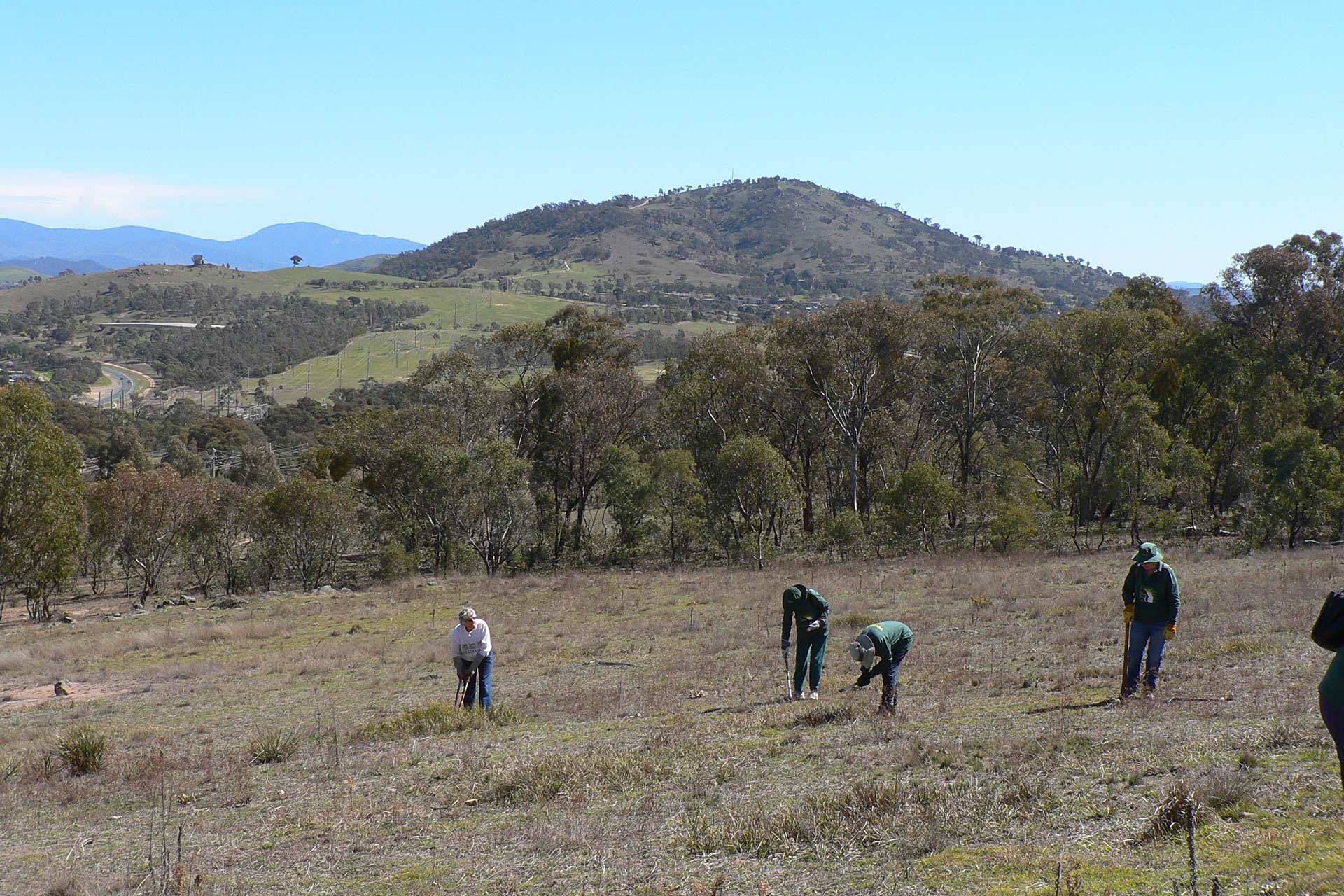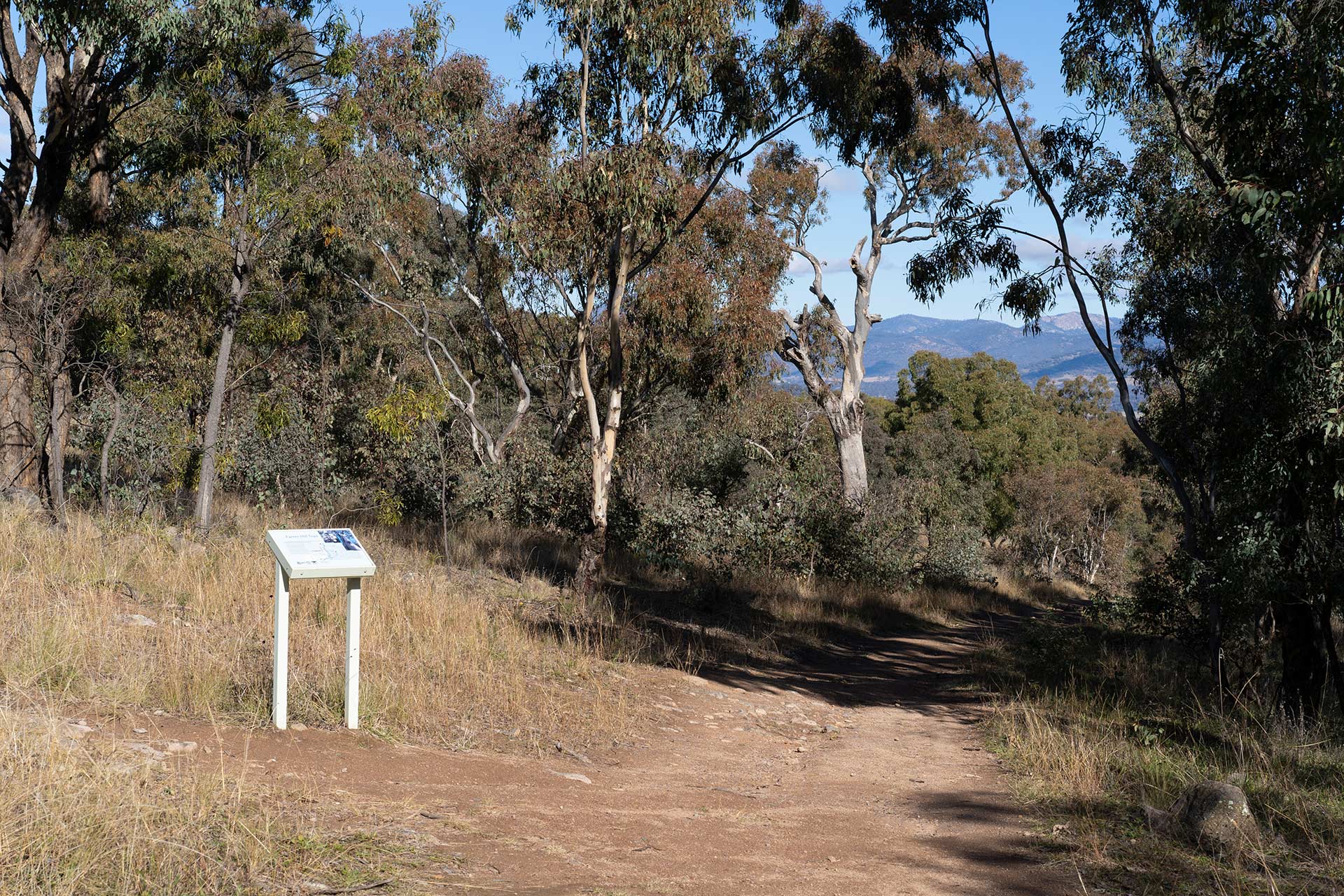Thanks to the work of its ParkCare Group, Farrer Ridge continues to thrive
The Farrer Ridge ParkCare group has been looking after Farrer Ridge Nature Reserve for over 30 years. Initiated by Jennie Widdowson and Leon Horsfeld in 1989, when Landcare was first establishing itself, the group has been instrumental in caring for the reserve. Their commitment to the management and conservation of Farrer Ridge Reserve is evident through their activities including vegetation mapping, planting, weed removal, creating interpretive signage, educating the community, and citizen science projects. Wendy Rainbird took the reins as convenor of the group in 1991
Volunteering type: environmental
Contributed by: Wendy Rainbird
One of our first activities at Farrer Ridge was to rehabilitate a site that had been disturbed by the building of power lines and a water reservoir. We received a grant from ACTEW to do this, and remediated the site by strategically planting native species suited to the area. Despite a long hot summer, most of the plants survived and they have flourished since. This was an encouraging start to the group’s efforts.

In a later project, I put my geography background to good use together with another volunteer who was an ecologist. We decided to map the vegetation across the entire reserve and record the dominant species: trees, bushes, grasses and the weeds. Despite much of the area having been cleared for grazing and introduced grasses brought in, we noticed in the mapping work that the rocky knolls did not have weeds and were remarkably biodiverse. These beautiful places were important to conserve. We also identified the threatened Yellow Box-Red Gum Grassy Woodland ecosystem highlighted in the Canberra Nature Reserves Management Plan. Other group members found orchids, Swainsonia (native peas) and tiny Fairy Aprons, so places where special plants were found were mapped. These findings shifted our efforts towards conserving the areas of vulnerability and high biodiversity in the reserve.

After the mapping work, we turned our attention to a track up Farrer Hill that had been formed by people wanting to enjoy the 360-degree view from the summit. Because the soil is very gravelly with many small rocks, and does not hold well together, that track was starting to erode. Through the Southern ACT Catchment Group, we applied for a grant to make a walkway that had logs, swales and rock steps which channelled water away from the track.
We thought the track offered a chance to educate people about what grew nearby, so set to work on creating interpretive signs for visitors. The day after the text and photos were finalised in January 2003, the bushfires raged into Canberra from the Brindabella mountains. Farrer Ridge Nature Reserve was burnt black, except for a small, narrow area in the north east.
The PCS rangers said it had been terrifying trying to fight the fires. They described hearing and seeing very old trees crashing to the ground on the next day, indicated that the fires was probably the most severe in 200 years. Fortunately, most eucalypts in the nature reserve survived and resprouted. The Acacias and Cassinias (both shrub species) recovered more slowly, growing back from seeds or rootstock. A surprise was the appearance of Kurrajong trees, which had not been at the reserve before the fires!

After the fires, we used our mapping work to inform the selection of four sites with different vegetation types to observe regrowth and recovery. We used Greening Australia’s guidelines to ensure consistency, monitored the sites for five years, and produced a report showing the changes over time.
In 2004, we were able to complete the interpretive signs and track work with help from PCS rangers and Conservation Volunteers Australia.
Meanwhile, we continued removing woody weeds – Cotoneaster, Pyracantha, Briar Roses and Blackberries. These are often found under large eucalypts, as birds eat the berries then fly up and sit in the trees; the seeds then sprout from their droppings.
At that time, the rangers would work alongside us. We learnt from each other because some of our volunteers were very knowledgeable about plant identification. It was at volunteer meeting that we learned that Verbascum, a perennial weed we had been told was not a weed of significance, can produce up to 400,000 seeds per plant. Unfortunately, this has resulted in thick infestations of Verbascum. It has taken many hours of work over years to try to reduce the numbers of those weeds, while also keeping on top of woody weeds.

The ParkCare group has also had a strong connection to the local community. I run guided walks with students from Farrer Primary school, and have given presentations to the students and organised planting events for them. We also host an annual wildflower walk in Spring, sharing the bio-diverse woodlands and special plants in flower.
In 2019, Ngunawal Elder Wally Bell led an interpretive walk at Farrer Ridge Nature Reserve. While preparing for this walk, Wally found a scar tree at the reserve. It is exciting to know that people have been using this area for thousands of years before us, and we hope that our care for the ridge will mean others can enjoy its natural beauty long into the future.
Erosion Control Project
Through the Southern ACT Catchment Group, we received training on erosion control from a specialist and then held a working bee to put our learning into practice. We constructed erosion control measures from local materials, with some help from star pickets and fencing wire to hold logs in place. Thanks to the expert advice we had on-hand, we were able to use different techniques for different types of erosion.

To complement our engineering works, we planted the sites with local species and watered them in during the drought. The plants have grown well and although over time and storms, some of the logs and branches for erosion control have dislodged, most are intact and still doing their job.


